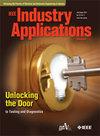Flicker Visibility With Different Spectra of White Light
IF 4.5
2区 工程技术
Q2 ENGINEERING, ELECTRICAL & ELECTRONIC
引用次数: 0
Abstract
The standard flickermeter (voltage flickermeter) algorithm commonly used for the evaluation of flicker severity in current electromagnetic compatibility standards originates from the 1980s. It was developed to mimic irritation of an average human observer by flickering incandescent lamp as a reference light source and optimized to voltage fluctuations caused by arc furnaces. However, the algorithm is questionable as the situation in the grid changed since the 1980s; many modern devices are being connected to the grid, creating voltage distortion patterns which are not properly recognized by the voltage flickermeter. In addition, incandescent lamps have been largely replaced by discharge lamps and later by LEDs. Transitioning the algorithm from incandescent lamp light to LED light requires detailed revision of every part of the algorithm. This paper is concerned with verifying the frequency weighting function of the average human observer which is one of the bases of the voltage flickermeter, as well as of the derived light flickermeter. Flicker sensitivity of 34 human observers is measured with two different light sources (LED warm and neutral white, incandescent lamp) and compared with the frequency weighting function used in the current specification of the flickermeters in standards. Finally, an optimization of the weighting function is proposed based on the findings.不同白光光谱的闪烁可见性
现行电磁兼容标准中常用的闪烁严重程度评价标准闪变计(电压闪变计)算法起源于20世纪80年代。它的开发是为了模拟普通人类观察者的刺激,通过闪烁的白炽灯作为参考光源,并优化了电弧炉引起的电压波动。然而,自20世纪80年代以来,随着电网情况的变化,该算法受到质疑;许多现代设备被连接到电网,产生电压失真模式,而电压闪变计不能正确识别。此外,白炽灯在很大程度上被放电灯取代,后来又被led取代。将算法从白炽灯转换为LED灯需要对算法的每个部分进行详细的修改。本文讨论了作为电压闪变计基础之一的普通人类观察者的频率加权函数的验证,以及由此衍生的光闪变计的验证。用两种不同的光源(LED暖白光和中性白光、白炽灯)测量了34名人类观察者的闪烁灵敏度,并与现行标准中闪烁计规格中使用的频率加权函数进行了比较。最后,根据研究结果对权重函数进行了优化。
本文章由计算机程序翻译,如有差异,请以英文原文为准。
求助全文
约1分钟内获得全文
求助全文
来源期刊

IEEE Transactions on Industry Applications
工程技术-工程:电子与电气
CiteScore
9.90
自引率
9.10%
发文量
747
审稿时长
3.3 months
期刊介绍:
The scope of the IEEE Transactions on Industry Applications includes all scope items of the IEEE Industry Applications Society, that is, the advancement of the theory and practice of electrical and electronic engineering in the development, design, manufacture, and application of electrical systems, apparatus, devices, and controls to the processes and equipment of industry and commerce; the promotion of safe, reliable, and economic installations; industry leadership in energy conservation and environmental, health, and safety issues; the creation of voluntary engineering standards and recommended practices; and the professional development of its membership.
 求助内容:
求助内容: 应助结果提醒方式:
应助结果提醒方式:


